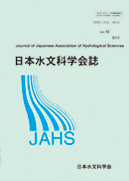Volume 40, Issue 3
SPECIAL ISSUE "Sustainable groundwater management based on the regional hydrological cycle"
Displaying 1-8 of 8 articles from this issue
- |<
- <
- 1
- >
- >|
FOREWORD
-
2010 Volume 40 Issue 3 Pages 67-69
Published: 2010
Released on J-STAGE: March 25, 2011
Download PDF (241K)
GENERAL ARTICLE
-
2010 Volume 40 Issue 3 Pages 71-84
Published: 2010
Released on J-STAGE: March 25, 2011
Download PDF (1162K) -
2010 Volume 40 Issue 3 Pages 85-93
Published: 2010
Released on J-STAGE: March 25, 2011
Download PDF (2265K) -
2010 Volume 40 Issue 3 Pages 95-108
Published: 2010
Released on J-STAGE: March 25, 2011
Download PDF (1682K) -
2010 Volume 40 Issue 3 Pages 109-120
Published: 2010
Released on J-STAGE: March 25, 2011
Download PDF (2422K) -
2010 Volume 40 Issue 3 Pages 121-134
Published: 2010
Released on J-STAGE: March 25, 2011
Download PDF (2011K) -
2010 Volume 40 Issue 3 Pages 135-143
Published: 2010
Released on J-STAGE: March 25, 2011
Download PDF (444K) -
2010 Volume 40 Issue 3 Pages 145-147
Published: 2010
Released on J-STAGE: March 25, 2011
Download PDF (219K)
- |<
- <
- 1
- >
- >|
